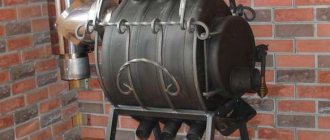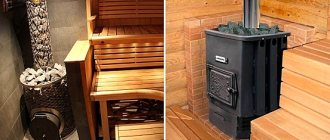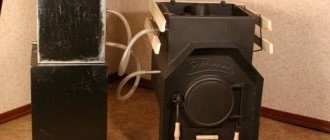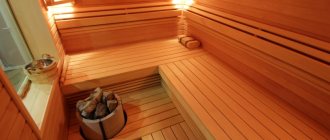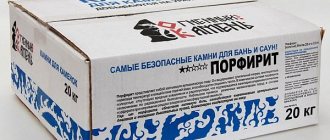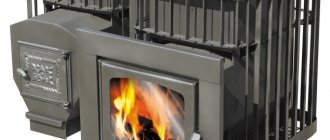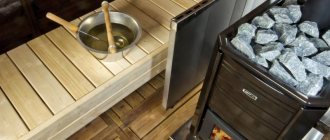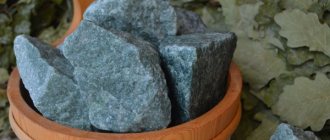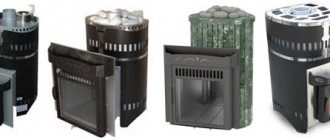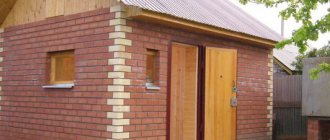27.03.2018
Electric sauna stoves are in great demand today - there are many who want to make a sauna in their home or even apartment.
Samples of heaters that have a capacity of up to 40 kg of stones can only be suitable for saunas, and up to 120 kg can be used in the “Russian bath” mode. But no matter what the capacity of the oven may be, the procedure for filling it itself is associated with some safety rules, which will be presented below.
Principle of choosing stones
To be absolutely sure of the quality of stones for the heater and their safety for health during use, they should be purchased only from specialized sales outlets. Under no circumstances should you use natural materials with unclear properties and origin, since when heated they can release substances hazardous to health.
But when purchasing stones in stores, you can find out all their characteristics, starting with the rock and ending with its properties.
Among the most important characteristics of heater stones are:
- heat capacity - that is, the ability of a stone to accumulate and gradually release heat into a room so that it maintains the desired temperature longer;
- heat resistance - an indicator that determines the temperature threshold that a material can withstand without losing its original characteristics;
- non-toxic – no evaporation of any harmful components;
- environmental friendliness;
- susceptibility to expansion - for a stone it must be very low, otherwise it will crumble.
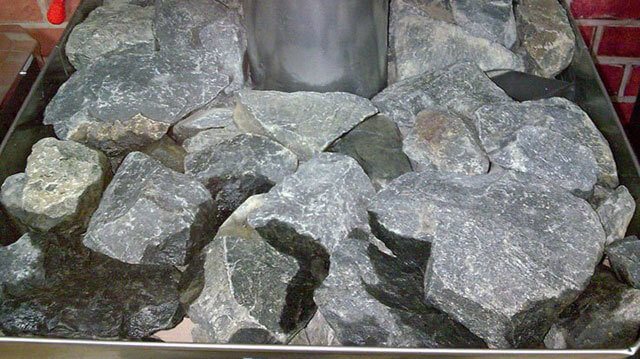
Currently, the following types of stones for sauna stoves can be purchased at points of sale:
- Basalt . This stone is one of the most durable and durable options used in sauna heaters. The stone retains its integrity for a long time, does not crumble, and is also able to accumulate heat well, so that the bathhouse does not cool down for a long time.
- Gabbro-diabase . This material consists of a whole set of minerals, since it is of volcanic origin. All components of the rock are safe for human health, therefore they can be absolutely freely used for laying a heater, since the material has all the necessary characteristics and is quite inexpensive.
- Jadeite . This mineral is classified as a semi-precious stone and is endowed with a list of properties that make it suitable for use in a bath. It is very durable, does not absorb water, is very durable and has high heat transfer rates.
- Quartzite . This rock contains 90% quartz, which heats up very quickly. This quality is actively used for the construction of a heater, however, only in combination with other stones.
- Peridotite . Material containing pyroxene and olivine. Such stones are safe for human health, because they do not contain harmful impurities and can withstand significant temperature loads, since they belong to the category of volcanic rocks.
- Soapstone chlorite . This material has a number of properties necessary for a steam room. It is able to evenly distribute the thermal energy accumulated in advance, due to which the heating of the bath occurs gradually and is maintained for a long time. The mineral can heat up to 16,000 ºС.
- Chromite . For the most part, the mineral consists of chromium, so it is safe for health, does not expand as a result of heating, is very dense and very heavy.
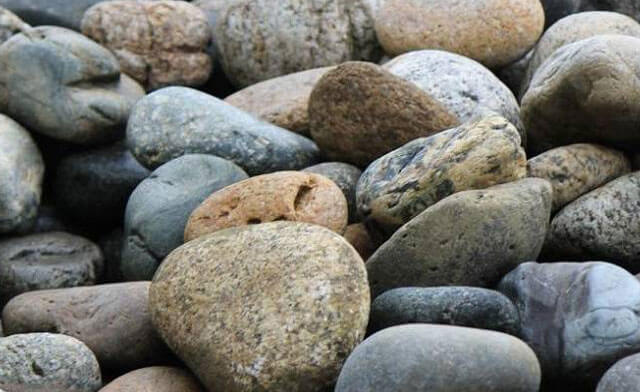
In addition to the type of stone for the sauna stove, its type should also be taken into account, since it determines how to lay the stones in the sauna stove. If we are talking about an electric oven, then it will require small stones, about 5-8 cm in diameter. This is due to the fact that such stoves are small in size, which means that the heater will also be small. In addition, in this case, stones are placed in the sauna stove between the heating elements, so the size of the stones must correspond to the distance between them, but not damage the electrical components.
Selection of stones and their placement
The darker the color of the breed, the higher its strength and reliability. The best stones for electric heaters in this regard are igneous stones, which are several tens of millions of years old. The surface should be smooth, free of sharp corners. Laying stones must be carried out according to a certain principle, for this reason you should approach the task as responsibly as possible. It is necessary to check the stones for cracks; they must be absent, otherwise the stone may crack under the influence of temperature.
A reliable way to test is to throw stones into the fire and pour water on them immediately after. Stones that have not cracked due to this are suitable for installation.
How to lay stones? It is necessary to leave gaps for the free passage of flue gases. Laying is carried out according to the rule of transition from larger to smaller. The size of the stones varies in the range of 8-20 cm. Thanks to this, heat accumulation occurs correctly and it is possible to ensure the optimal temperature inside the steam room and the optimal ratio of heat to steam. You cannot make the masonry dense; it should be taken into account that when heated, the stones will expand.
Stones for electric heaters - which ones are better? The best rocks are jadeite, basalt, crimson quartzite, soapstone and gabbro-diabase.
How to lay stones in a bathhouse
Once you have decided on the type of materials for the stove, you need to clarify how to lay the stones in the sauna stove. The quality and quantity of steam generated above the heater, as well as the circulation of gases, will depend on their correct installation. This process will require time and patience, because all the stones have an irregular shape, so you can’t just pour them out randomly, but you need to make sure that there are gaps between them.
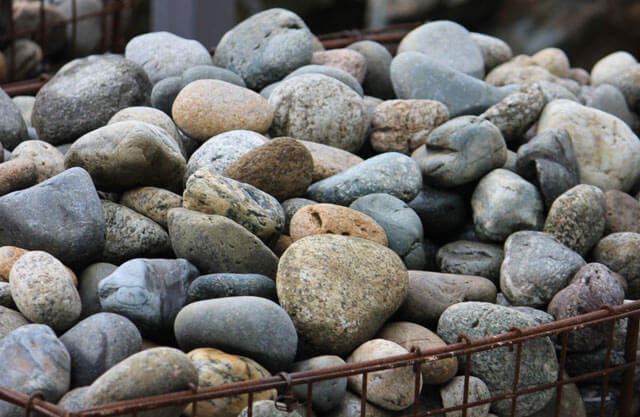
Before placing the stones in the bathhouse, they should be rinsed with running cold water. The masonry of the heater is carried out starting with the largest specimens and ending with the smallest. Stones should be laid on the heated surface with narrow ribs so that they warm up faster and do not reflect heat back into the oven.
Experienced stove makers recommend using stones at the rate of 35-45 kg per 1 m3 of room. This ratio will allow you to create the desired level of heating and optimal conditions in the steam room.
As for care, nothing overly complicated is required in this case. At least once a year, the stones should be washed with water to remove accumulations of dirt and bacteria that can spread an unpleasant odor. If stones with defects appear, they also need to be replaced once a year with good and intact ones. But a complete overhaul and replacement of stones in the heater is recommended to be done every 3 years. The fact is that after this time the stones begin to lose their qualities, heat transfer decreases, they become brittle and brittle.
Convection or IR radiation
The first step was to inspect the stove during combustion. And not just examined, but with the lights off. This makes it clear where the metal is heated red-hot. An examination confirmed that the walls of the heater glow from crimson to scarlet during combustion. This means there is temperature and the stones are heating up. The heating time at 20 degrees is about an hour, this time should be enough to warm up the bookmark. What's the matter?
Let's not drag out the intrigue and say right away that the reason was the wrong way of laying the stones.
You've probably already come across tips and drawings that say that pebbles should be laid vertically on their edges? Here, for example, is a drawing.
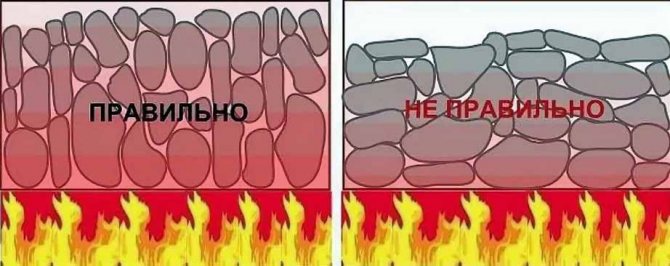
Methods for laying stones in a sauna stove if convection is needed
The motivation for these recommendations is simple: convective currents of hot air move from bottom to top. To make it easier for the heat to pass through, you need to make the laying vertical, then the air will easily pass from the heated metal to the top pebbles and heat them up.
It is difficult to argue with such arguments, because this is elementary physics, and, indeed, hot air obeys the indicated principle (draft in a chimney works in the same way). There is only one important “BUT” that is often forgotten.
The fact is that such movements occur in systems in which not only the free outflow of air in the upper part is ensured, but also its free flow in the lower part! Try closing the vent while the stove is running. What will happen to the cravings? Will hot air from the furnace firebox and chimney rise up and fly out into the street?
No, this will not happen, since the lack of inflow will not allow this to happen: as soon as the heat wants to escape, a vacuum will be created in the pipe, which will immediately stop the movement.
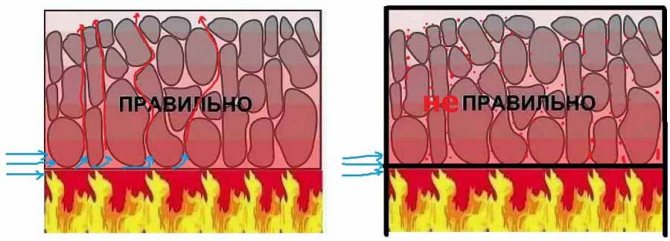
On the left, the heater is open, so air freely enters the lower part of the stove and, when heated, rushes upward. On the right, the heater is closed on all sides and fresh air does not have access to it, and therefore only small convective currents are observed inside
Why are we telling this? Moreover, in most cases, stoves with an internal heater do not have any significant ventilation of the stone core. Therefore, the principle of convective heating is practically absent in them. Therefore, laying stones in a closed heater according to the convective principle will practically not provide additional temperature indicators.
On the contrary, in reality such heaters are closed so that the filling in them is not cooled by air currents and warms up to maximum values. And heating is carried out exclusively due to infrared radiation. That is why we checked whether the metal of the furnace was heated red-hot, since this is an indicator of temperature and the presence of a large number of IR rays.
Hence the first conclusion: when laying rock in an internal heater, there is no need to focus on convective flows.
By the way, in our example, the bookmark was made vertically, based on advice about convective heating.
What happens to the stones inside a closed furnace backfill?
In my bathhouse there is a brick stove, the stones are hidden inside. They heat up from the flame and smoke passing through them.
The temperature there is certainly high! From heating, heating and subsequent cooling with water, stones become unusable over time.
Soot settles on the stones and soot appears. Any, even the most durable and hard stone, cracks and crumbles due to temperature changes. It's unavoidable!
Small stone chips clog the passages between the laid stones. As a result, the smoke simply has nowhere to go, the stove begins to smoke and all the soot settles on the stones. One trouble leads to others.
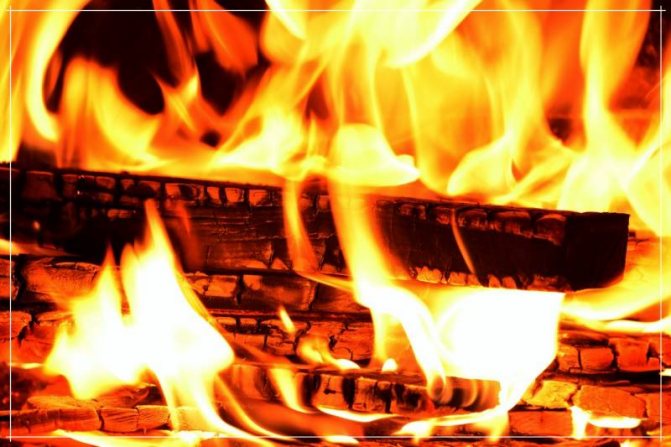
The accumulated soot envelops the stone like a velvet blanket; it does not heat up well. An unpleasant, subtle smell of burning and smoke appears in the bathhouse.
When water is applied to such stones, clean ash flies back into the bath with the escaping steam. In addition, the accumulated soot can catch fire and in a “neglected” heater you can get a real fire. And if the pipe is already closed, a fire is guaranteed!
In the old days, baths ended their lives in the same way - they died from a fire or simply rotted. To prevent such an end for your bathhouse kingdom, not much needs to be done. The main thing is not to be lazy! So, let's begin!
How to reject stones
Stones damaged by fire troops are in no way suitable for re-loading into the furnace. Broken or cracked ones need to be replaced. Carefully inspect the surface of your stones, if it has changed dramatically in color, has become porous, uneven, or lumpy - such stones are no longer suitable for serving in a sauna stove.
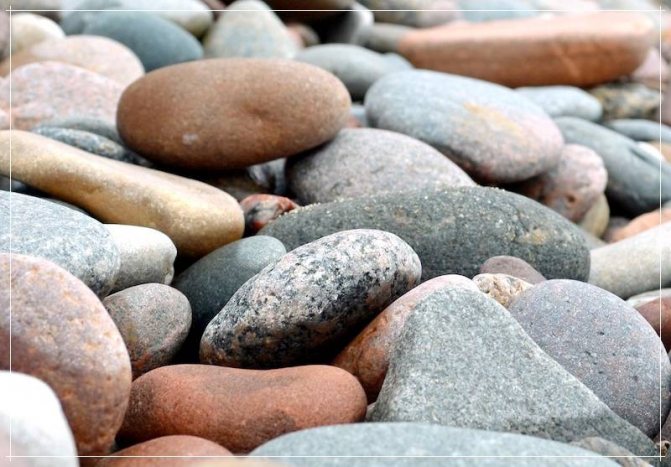
If you are not sure about the strength of the stone, check it with a regular hammer. Do not regret what has already served its time. Remember the saying - “The miser pays twice”!
